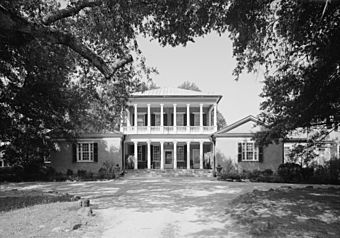Borough House Plantation facts for kids
|
Borough House
|
|
|
U.S. Historic district
Contributing property |
|
 |
|
| Location | SC 261, N. Kings Hwy. Stateburg, South Carolina |
|---|---|
| Built | 1758, 1820 |
| Architect | William Wallace Anderson, M.D. |
| Architectural style | Greek Revival, Rammed earth |
| Part of | Stateburg Historic District (ID71000809) |
| NRHP reference No. | 72001224 |
Quick facts for kids Significant dates |
|
| Added to NRHP | March 23, 1972 |
| Designated NHL | March 23, 1972 |
| Designated CP | February 24, 1971 |
Borough House Plantation, also known as Borough House, Hillcrest Plantation, or Anderson Place, is a very old and important historic site in Stateburg, South Carolina. It's located near Sumter, South Carolina, in an area called the High Hills of Santee.
This plantation is special because it has the largest collection of buildings made from a unique material called pisé, or rammed earth, in the entire United States. The main house and six other buildings were built using this method, starting in 1821. Borough House was also once the home of a famous soldier, Confederate Army General Richard H. Anderson.
A House with History
The very first house on this site was built way back in 1758. During the American Revolution, this house was used as a headquarters by important generals. At different times, both British General Charles Cornwallis and American General Nathanael Greene stayed here.
The town of Stateburg was originally called Stateborough. When the town was first planned, Borough House was the only home there. That's how it got its name!
Built from Earth!
One of the most amazing things about Borough House is how many of its buildings are made from rammed earth. This is an ancient building technique where damp soil is packed down tightly to create strong walls. It's like making a giant, solid block out of dirt!
From 1850 to 1852, Dr. Anderson, who lived at Borough House, helped build the Church of the Holy Cross. This church, located right across the road from Borough House, was also built using the rammed earth method.
Famous Visitors
In 1851, a very interesting person named Joel Roberts Poinsett visited Dr. Anderson at Borough House. Joel Poinsett was a doctor, a statesman (meaning he was involved in government), and a botanist. He's famous because the beautiful red and green plant we know as the poinsettia is named after him! Sadly, Joel Poinsett passed away while visiting Borough House and was buried in the churchyard across the road.
Because of its unique history and special architecture, Borough House Plantation was added to the National Register of Historic Places on March 23, 1972. It was also recognized as a National Historic Landmark, which means it's considered one of the most important historic places in the United States.



